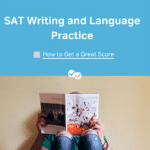The Writing section of the SAT has undergone one of the most obvious changes of the whole exam. All of the questions are now within the context of a passage, which makes the test much more like the real-world task of editing a paper or article. This might make this section seem daunting, but we have some tricks that’ll help you face it with confidence.
Tip #1: Know your enemy.
In this article, we won’t get into each type of writing error that the SAT includes, but you should know that there are two general types of questions on the Writing section: narrow-focus questions and broad-focus questions.
- Narrow-focus questions ask about diction (word choice), sentence construction of one particular sentence, and mechanical details such as punctuation.
- Broad-focus questions ask you to judge and make changes to the organization within paragraphs and the passage itself; they include questions about tone, topic sentences, and conclusions.
Trick #2: Start with the details.
It’s a good idea to answer the narrow-focus questions first. They require very little reading and can be answered quickly, letting you rack up those precious points. The idea is to lock down the easier/faster points first. If you run out of time, you can guess on the questions you didn’t get to, but you don’t want to miss out on some you could have answered easily because you got caught up on a hard question. Plus, getting these right can give you a nice confidence boost as you approach the more complex questions.
Tip #3: Tackle the broad-focus SAT questions strategically.
Read the question, then re-read the section of the passage that it refers to. Decide what you think needs to be done before you look at the answer choices. Then look for an answer choice that matches your idea. If there isn’t one, test out each answer choice in context. Finally, always read your choice back as part of the paragraph or passage to make sure it flows logically. Following this sort of strategy will take some of the stress out of these questions and help you avoid getting stuck on them.
Trick #4: Don’t be afraid to pick NO CHANGE.
Many questions on the Writing section provide NO CHANGE as a possible answer. Many students hate picking this answer, because they always feel like it can’t possibly be fine and they are missing something. It is true that most questions will include an error of some kind, but there will always be a couple of correct ones, too. A good rule is that if you get 5 or more NO CHANGE answers in a single passage, take a second look at them, since it is rare to have that many concentrated in one selection. The best way to build confidence on these questions is to study the types of errors the SAT will make. If you’re sure that the selection makes none of these, NO CHANGE might just be the right choice.
Tip #5: Pay attention to tone on SAT Writing.
Understanding the tone of a passage can help you on a variety of question types. Broad-focus questions will often ask you to choose an appropriate sentence to be added to the passage. Several of the sentences may be on the correct topic, but only one will include the right topic and the right tone. Tone can also be useful on narrow-focus questions such as those that ask you to pick the correct word in context. The options often have similar meanings but different connotations. Use your knowledge of the passage’s tone to select the best word for the job.
Editing long passages may seem daunting, but arming yourself with knowledge and strategy can help you go into the Writing section of the New SAT ready to do battle and win!






Leave a Reply